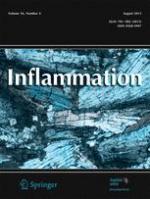Citation:
Ginsburg I, Sela MN, Morag A, Ravid Z, Duchan Z, Ferne M, Rabinowitz-Bergner S, Thomas PP, Davies P, Niccols J, et al. Role of leukocyte factors and cationic polyelectrolytes in phagocytosis of group a streptococci andCandida albicans by neutrophils, macrophages, fibroblasts and epithelial cells. Inflammation. 1981;5 (4) :289-312.

Abstract:
A variety of cationic polyelectrolytes opsonized group A streptococci andCandida albicans to phagocytosis by human polymorphonuclear leukocytes and by mouse peritoneal macrophages. The most potent opsonins for streptococci were specific antibodies supplemented with complement, nuclear histone, polylysine, polyarginine, ribonuclease, leukocyte lysates, leukocyte cationic protein and, to a lesser extent, lysozyme and myeloperoxidase. Histone, RNAse, leukocyte extracts, and platelet extracts also functioned as opsonins for phagocytosis of streptococci in the peritoneal cavity, where phagocytic indices, higher than those obtained for the in vitro phagocytosis, were obtained. Fresh serum, polylysine, polyarginine, and nuclear histone acted as good opsonins forCandida, but none of the other factors tested were active. In order for the cationic proteins and leukocyte extracts to function as opsonins, they must be present on the particle surface. These agents were poor opsonins when applied on the macrophages. Nuclear histone, polylysine, polyarginine, and fresh human serum also functioned as good opsonins for the uptake ofCandida by mouse fibroblasts. On the other hand, none of the other substances which opsonized streptococci were effective withCandida. The phagocytic capabilities of fibroblast polykaryons were much higher than those of ordinary spindle-shaped mouse fibroblasts. Histone also functioned as a good opsonic agent for the uptake ofCandida by human fibroblasts, HeLa cells, epithelial cells, monkey kidney cells, and rat heart cells. On the other hand, neither leukocyte extracts nor ribonuclease LCP or MPO functioned as opsonins for these mammalian cells.Candida, taken up by fibroblasts, were present within tight phagosomes, but no fusion of lysosomes with the phagosome occurred. A small proportion of the internalized yeast cells underwent partial plasmolysis, but little damage to the rigid cell walls was observed within 24–48 h of internalization. Phagocytosis of streptococci andCandida by macrophages and the uptake ofCandida by fibroblasts were both strongly inhibited by liquoid (polyanethole sulfonic acid sodium salt). This anionic polyelectrolyte also markedly inhibited the release ofN-acetylglucosaminidase from macrophages without affecting cell viability (LDH release). Hyaluronic acid, DNA, and dextran sulfate markedly inhibited the uptake of histone-coated particles by macrophages. On the other hand, hyaluronic acid and DNA enhanced the uptake ofCandida by fibroblasts. The effect of these anionic polyelectrolytes on phagocytosis of serum-opsonized particles by macrophages was not consistent. While in some experiments it blocked phagocytosis, in others it either had no effect or even enhanced the uptake of the particles. Phagocytosis of microorganisms by “nonprofessional” phagocytes like fibroblasts and the paucity in these cells of hydrolases capable of breaking down microbial cell wall components may contribute to the persistence of non-biodegradable components of bacteria in tissues and to the perpetuation of chronic inflammatory sequellae. Cationic polyelectrolytes may also prove important as “helper” opsonins and as agents capable of enhancing the penetration into cells of both viable and nonviable particles, genetic material, and drugs.Publication Global ID: http://link.springer.com/article/10.1007/BF00911094

